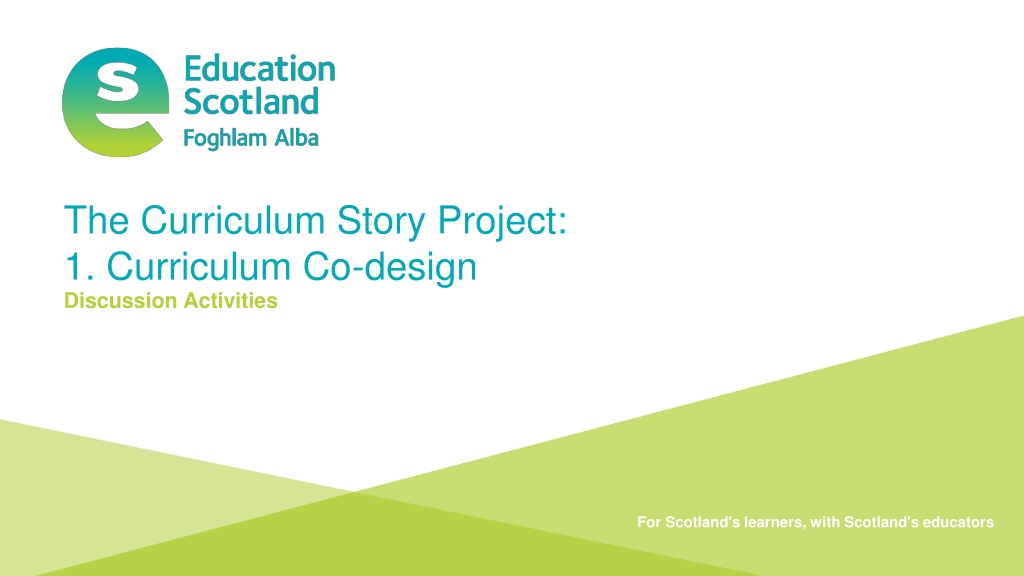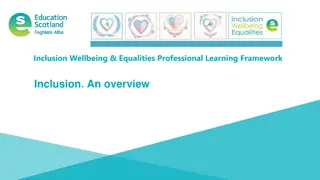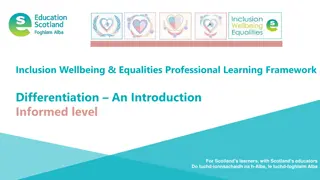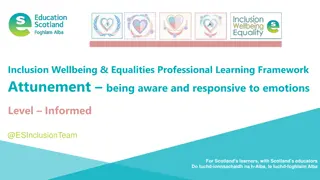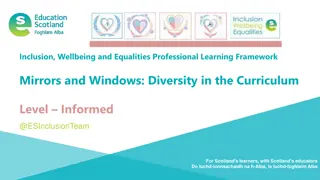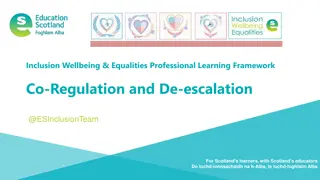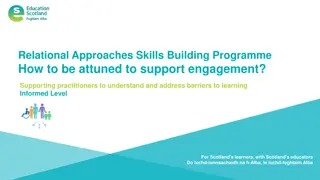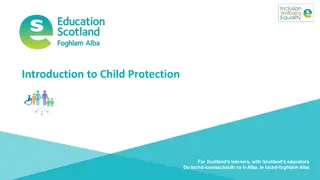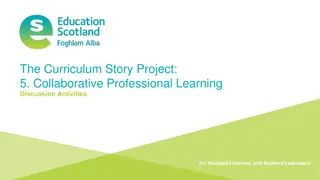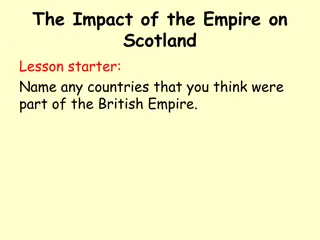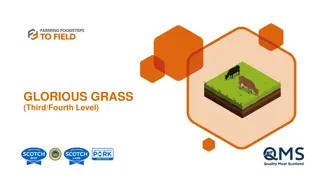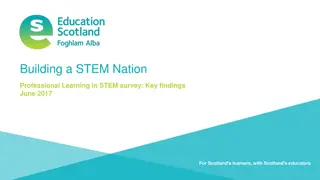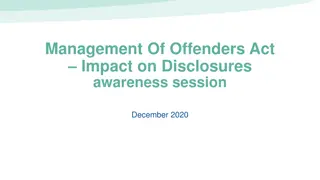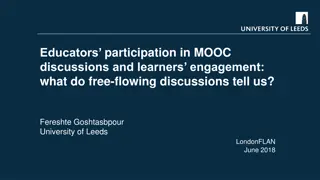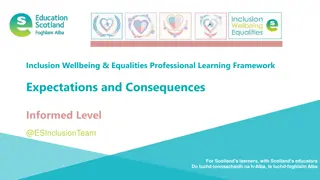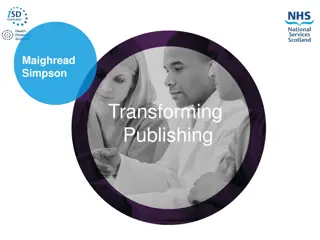Curriculum Co-design Activities for Scotland's Educators
Practical activities and discussion points aimed at educators in Scotland to enhance curriculum co-design and interdisciplinary learning. The Curriculum Story Project provides case studies and ideas to promote collaborative planning and innovative approaches to curriculum development. The activities encourage reflection on unique school contexts, challenges faced in co-designing curricula, and potential application of design approaches. Transforming lives through learning!
- Curriculum co-design
- Scotland educators
- Interdisciplinary learning
- Reflective practice
- Collaborative planning
Download Presentation

Please find below an Image/Link to download the presentation.
The content on the website is provided AS IS for your information and personal use only. It may not be sold, licensed, or shared on other websites without obtaining consent from the author. Download presentation by click this link. If you encounter any issues during the download, it is possible that the publisher has removed the file from their server.
E N D
Presentation Transcript
The Curriculum Story Project: 1. Curriculum Co-design Discussion Activities For Scotland's learners, with Scotland's educators Transforming lives through learning The Curriculum Story Project: 1. Curriculum Co-design
How to use this download pack The discussion and practical activities in this pack connect to the case studies and ideas around interdisciplinary learning of The Curriculum Story Project 1: Curriculum Co-design. While there is value in using them as standalone resources, we encourage teams to read the case studies, together, as part of their own reflective practice. From 2020-22, The Curriculum Story Project from Education Scotland brought together nearly 200 practitioners to understand the components, processes, and thinking behind successful interdisciplinary learning and the development of broader learner pathways. The case studies and activities are designed by NoTosh, a firm specialised in helping people think differently and choose the way they learn and work. Transforming lives through learning The Curriculum Story Project: 1. Curriculum Co-design
Discussion activities First read the case studies for The Curriculum Story Project - Curriculum Co-design. Then use one of these discussion points for a learning session or team meeting. Discussion 1. How do you approach Curriculum Design in your school or setting? For example, what is unique about the context of your school or setting that you could amplify when considering the Curriculum Design of IDL projects? Discussion 2. What challenges do you face in your school to be able to co-design and prototype the curriculum? For example, how do you ensure there is adequate time and space to plan collaboratively? Discussion 3: What aspects of the Curriculum Design approaches from the Curriculum Stories could you apply in your school or setting? For example, would you consider experimenting with a design cycle approach? For Scotland's learners, with Scotland's educators For Scotland's learners, with Scotland's educators The Curriculum Story Project: 1. Curriculum Co-design
The Curriculum Story Project: 1. Curriculum Co-design Practical Activities For Scotland's learners, with Scotland's educators Transforming lives through learning The Curriculum Story Project: 1. Curriculum Co-design
Find the root cause behind the barriers to co-design Find the root cause getting in the way of curriculum co-design What are the key hurdles to more co-design of the curriculum? Use the Five Whys to find the root causes. Pick a key problem you re facing and probe it at least four or five times to see if there are other issues that need to be tackled to end up at the result you want. On the next slide is one worked example. The fifth why is maybe the question that leads to a creative idea on using time more effectively (in this case, senior leadership might want to look at investing in the time of someone else to take on administrative work so that educators are freed up for an hour a week to do more creative curriculum co-design work). Answering the fifth why question might help you overcome the hurdle to co-design of the curriculum. Sometimes you will hit a brick wall with this method. In that case, go back up to the first or second why and try reframing those questions around another aspect of the previous answer to see what different results transpire. For Scotland's learners, with Scotland's educators For Scotland's learners, with Scotland's educators The Curriculum Story Project: 1. Curriculum Co-design
Find the root cause behind the barriers to co-design: a worked example We can never get time together, at the same time, to plan together. Why can you not get time at the same time? Because in our secondary school, I m teaching when the people I would plan with are free, and vice versa. Why are you always teaching when your colleagues are not, and vice versa? Because the timetable has every teacher working up to capacity most of the time. Why do you have to plan together during the teaching time you have? Because the only time we re in school and not teaching is taken up by departmental meetings. Why do you not use your departmental meetings for curriculum co-design? Because there s administrative work we have to do for our subject, and it always gets done there. Why do you use departmental meetings to do administrative work, instead of seeking some additional administrative help to do it, and clear the time for curriculum development? For Scotland's learners, with Scotland's educators The Curriculum Story Project: 1. Curriculum Co-design
Hexagonal Curriculum Planning Prepare your materials Print out and cut up around 30-40 hexagons, about 5cm wide (big enough to write curriculum concepts, expectations or outcomes on). Brainstorm curricular concepts With colleagues from another discipline, map out the curricular concepts, expectations, outcomes, thinking skills or content you d normally be tackling in a given term. For Scotland's learners, with Scotland's educators For Scotland's learners, with Scotland's educators The Curriculum Story Project: 1. Curriculum Co-design
Hexagonal Curriculum Planning: a worked example, step one When thinking about an authentic project suitable for Broad General Education in Secondary School, an overarching concept for a social sciences specialist or Geography teacher might be Environment . On separate hexagons they would write down all the elements of Environment that they would like to explore. They would also write down the key thinking or discipline-specific skills needed to access the content, or show understanding. (See the example on the next slide) For Scotland's learners, with Scotland's educators The Curriculum Story Project: 1. Curriculum Co-design
WATER CYCLE AND THE PROBLEMS OF POLLUTION GLOBAL WARMING: WHY IS 1.5% SO IMPORTANT? CROSS-BORDER POLLUTION GREENWASHING GAP MINDER TOOL: GRAPH-READING ON POLLUTION, HEALTH, ECONOMY SEPA FLOODING WEBSITE: WILL WE FLOOD? DATA ANALYSIS SKILLS POVERTY AND POLLUTION
Hexagonal Curriculum Planning: a worked example, step two Meanwhile, an English teacher could also tackle this theme - what are the texts and language skills he could map out that relate to the Environment? An example of the hexagons chosen are on the next slide. For Scotland's learners, with Scotland's educators The Curriculum Story Project: 1. Curriculum Co-design
VIDEO: ALLITERATION AND THE ENVIRONMENT DISCURSIVE ESSAY WRITING SPEECH WRITING GRETA THUNBERG IN GLASGOW TEXT: TEXT: WRITING POETRY AS A PERSUASIVE TEXT RESEARCH SKILLS GOING, GOING, BY PHILIP LARKIN ANIMAL S PEOPLE BY INDRA SINHA
Hexagonal Curriculum Planning: a worked example, step three When both practitioners put their thinking together, an interdisciplinary project plan starts to emerge, with clear connections between concepts that might otherwise have been unconnected by each practitioner. For Scotland's learners, with Scotland's educators The Curriculum Story Project: 1. Curriculum Co-design
WATER CYCLE AND THE PROBLEMS OF POLLUTION SEPA FLOODING WEBSITE: WILL WE FLOOD? DATA ANALYSIS SKILLS SPEECH WRITING GAP MINDER TOOL: GRAPH- READING ON POLLUTION, HEALTH, ECONOMY METAPHOR, ALLITERATION AND THE ENVIRONMENT GLOBAL WARMING: WHY IS 1.5% SO IMPORTANT? GREENWASHING RESEARCH SKILLS VIDEO: TEXT: WRITING POETRY AS A PERSUASIVE TEXT TEXT: CROSS-BORDER POLLUTION POVERTY AND POLLUTION GRETA THUNBERG IN GLASGOW GOING, GOING, BY PHILIP LARKIN ANIMAL S PEOPLE BY INDRA SINHA DISCURSIVE ESSAY WRITING
Hexagonal Curriculum Planning: a worked example, step three And to share the planning, teaching and assessment, both educators can now spot the opportunities for sharing assessment throughout the project: For Scotland's learners, with Scotland's educators The Curriculum Story Project: 1. Curriculum Co-design
WATER CYCLE AND THE PROBLEMS OF POLLUTION ASSESSMENT: MAKE THE CASE FOR A CHANGE IN HABITS SEPA FLOODING WEBSITE: WILL WE FLOOD? ASSESSMENT: GIVE A PERSUASIVE, INSPIRING SPEECH DATA ANALYSIS SKILLS SPEECH WRITING GAP MINDER TOOL: GRAPH- READING ON POLLUTION, HEALTH, ECONOMY METAPHOR, ALLITERATION AND THE ENVIRONMENT GLOBAL WARMING: WHY IS 1.5% SO IMPORTANT? GREENWASHING RESEARCH SKILLS VIDEO: TEXT: WRITING POETRY AS A PERSUASIVE TEXT TEXT: CROSS-BORDER POLLUTION POVERTY AND POLLUTION GRETA THUNBERG IN GLASGOW GOING, GOING, BY PHILIP LARKIN ANIMAL S PEOPLE BY INDRA SINHA ASSESSMENT: MAP POLLUTION FROM ONE COUNTRY AGAINST ANOTHER ASSESSMENT: WRITE A PERSUASIVE TEXT DISCURSIVE ESSAY WRITING
Education Scotland Denholm House Almondvale Business Park Almondvale Way Livingston EH54 6GA T +44 (0)131 244 5000 E enquiries@educationscotland.gov.scot For Scotland's learners, with Scotland's educators For Scotland's learners, with Scotland's educators The Curriculum Story Project: 1. Curriculum Co-design
Transforming lives through learning The Curriculum Story Project: 1. Curriculum Co-design
